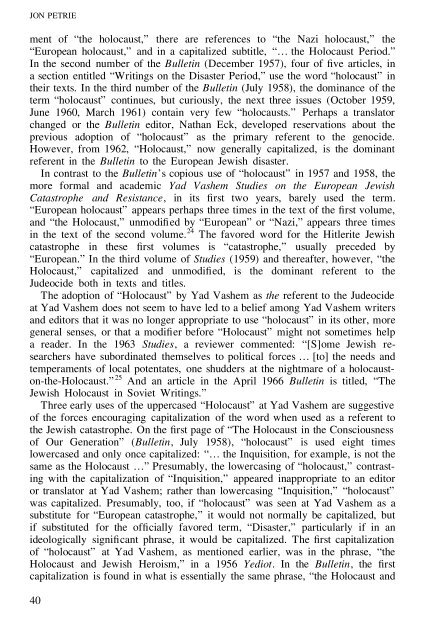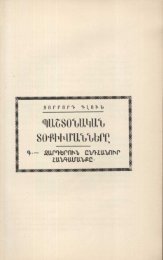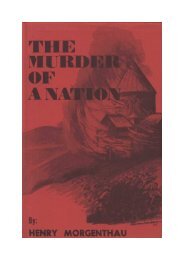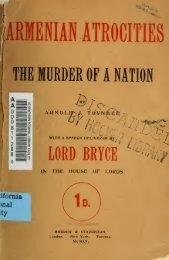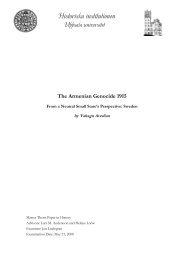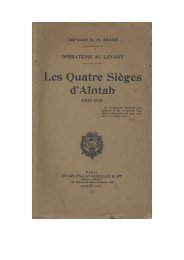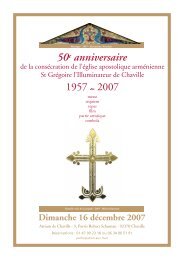The secular word HOLOCAUST: scholarly myths, history, and 20th ...
The secular word HOLOCAUST: scholarly myths, history, and 20th ...
The secular word HOLOCAUST: scholarly myths, history, and 20th ...
You also want an ePaper? Increase the reach of your titles
YUMPU automatically turns print PDFs into web optimized ePapers that Google loves.
JON PETRIEment of “the holocaust,” there are references to “the Nazi holocaust,” the“European holocaust,” <strong>and</strong> in a capitalized subtitle, “… the Holocaust Period.”In the second number of the Bulletin (December 1957), four of ve articles, ina section entitled “Writings on the Disaster Period,” use the <strong>word</strong> “holocaust” intheir texts. In the third number of the Bulletin (July 1958), the dominance of theterm “holocaust” continues, but curiously, the next three issues (October 1959,June 1960, March 1961) contain very few “holocausts.” Perhaps a translatorchanged or the Bulletin editor, Nathan Eck, developed reservations about theprevious adoption of “holocaust” as the primary referent to the genocide.However, from 1962, “Holocaust,” now generally capitalized, is the dominantreferent in the Bulletin to the European Jewish disaster.In contrast to the Bulletin’s copious use of “holocaust” in 1957 <strong>and</strong> 1958, themore formal <strong>and</strong> academic Yad Vashem Studies on the European JewishCatastrophe <strong>and</strong> Resistance, in its rst two years, barely used the term.“European holocaust” appears perhaps three times in the text of the rst volume,<strong>and</strong> “the Holocaust,” unmodi ed by “European” or “Nazi,” appears three timesin the text of the second volume. 24 <strong>The</strong> favored <strong>word</strong> for the Hitlerite Jewishcatastrophe in these rst volumes is “catastrophe,” usually preceded by“European.” In the third volume of Studies (1959) <strong>and</strong> thereafter, however, “theHolocaust,” capitalized <strong>and</strong> unmodi ed, is the dominant referent to theJudeocide both in texts <strong>and</strong> titles.<strong>The</strong> adoption of “Holocaust” by Yad Vashem as the referent to the Judeocideat Yad Vashem does not seem to have led to a belief among Yad Vashem writers<strong>and</strong> editors that it was no longer appropriate to use “holocaust” in its other, moregeneral senses, or that a modi er before “Holocaust” might not sometimes helpa reader. In the 1963 Studies, a reviewer commented: “[S]ome Jewish researchershave subordinated themselves to political forces … [to] the needs <strong>and</strong>temperaments of local potentates, one shudders at the nightmare of a holocauston-the-Holocaust.”25 And an article in the April 1966 Bulletin is titled, “<strong>The</strong>Jewish Holocaust in Soviet Writings.”Three early uses of the uppercased “Holocaust” at Yad Vashem are suggestiveof the forces encouraging capitalization of the <strong>word</strong> when used as a referent tothe Jewish catastrophe. On the rst page of “<strong>The</strong> Holocaust in the Consciousnessof Our Generation” (Bulletin, July 1958), “holocaust” is used eight timeslowercased <strong>and</strong> only once capitalized: “… the Inquisition, for example, is not thesame as the Holocaust …” Presumably, the lowercasing of “holocaust,” contrastingwith the capitalization of “Inquisition,” appeared inappropriate to an editoror translator at Yad Vashem; rather than lowercasing “Inquisition,” “holocaust”was capitalized. Presumably, too, if “holocaust” was seen at Yad Vashem as asubstitute for “European catastrophe,” it would not normally be capitalized, butif substituted for the of cially favored term, “Disaster,” particularly if in anideologically signi cant phrase, it would be capitalized. <strong>The</strong> rst capitalizationof “holocaust” at Yad Vashem, as mentioned earlier, was in the phrase, “theHolocaust <strong>and</strong> Jewish Heroism,” in a 1956 Yediot. In the Bulletin, the rstcapitalization is found in what is essentially the same phrase, “the Holocaust <strong>and</strong>40


